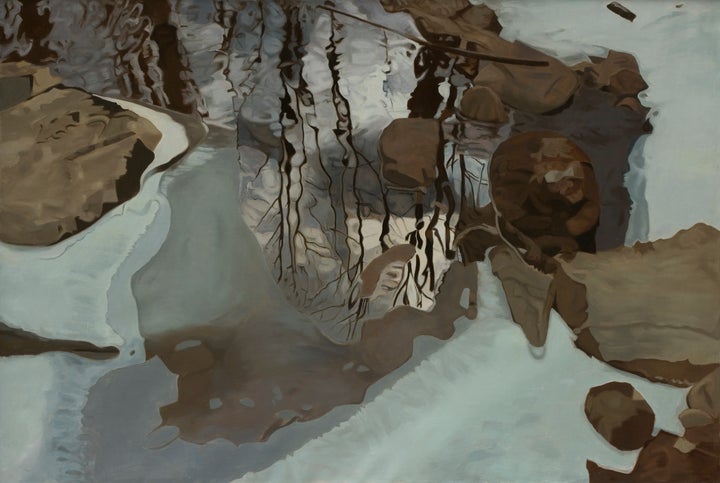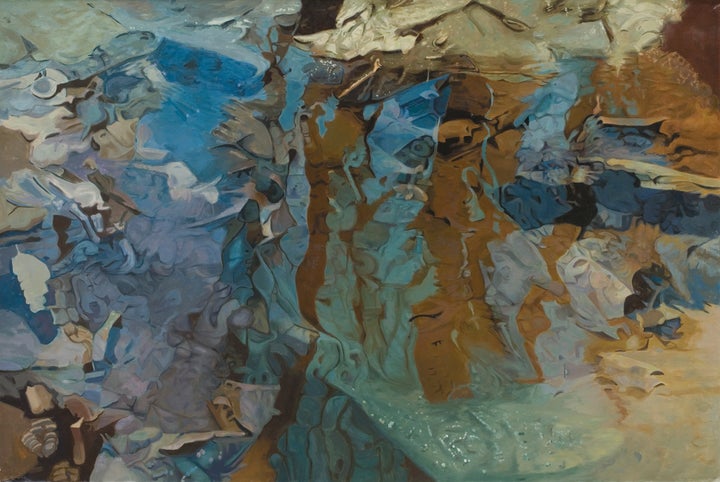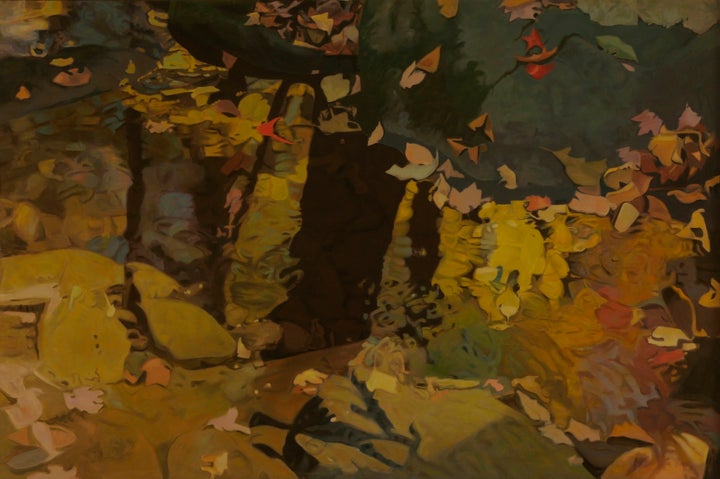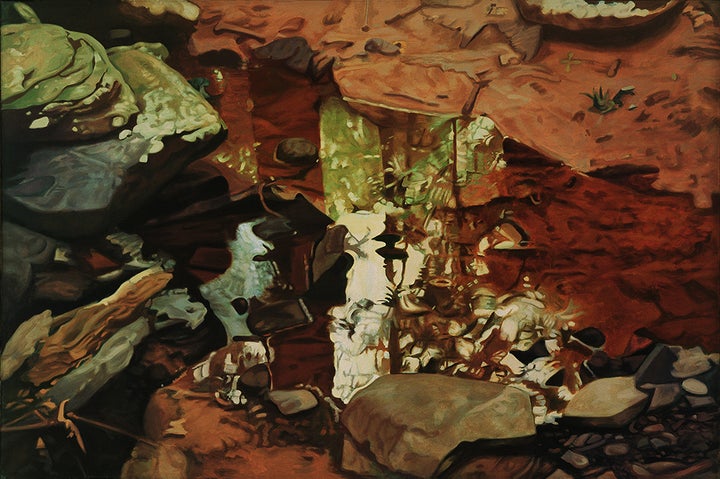
Ralph L. Wickiser, Winter Reflections, 1982, oil on linen, 47 x 70 inches
The life of Ralph L. Wickiser (1910-1998) spans the most complex and compelling time in art history. As the art world made its way through the Modern Age with movements such as Expressionism, Cubism, Dada, Surrealism, Futurism, Abstract Expressionism, Pop Art, Conceptualism, Minimalism and the like, all the way up to the great, and seemingly endless mix of the more recent artistic expression tagged with the moniker of Contemporary Art, Wickiser was developing his own theories about the projected path of new art. By the early 1970s he realized that there was little that had not already been done, and he decided to move onto an approach where abstraction and representation could be melded into one visual experience. This predictive, groundbreaking change where Wickiser synthesized two opposite approaches to artistic expression yielded a number of incredible works of art that have stood the test of time.
I recently had the opportunity to discuss with his son Walter Wickiser, the thoughts and memories of his father’s life work, remembering him as one of the most important artists of his day.
DDL: In reading about Ralph L. Wickiser it’s easy to see how he was positioned to make great strides in Contemporary Art. From his 1947 book An Introduction to Art Activities, to the artists he exhibited with such as Milton Avery, Willem de Kooning, Philip Guston, Georgia O'Keeffe, and Jackson Pollock; the professors he taught along side of: Franz Klein, Jacob Lawrence, and Philip Pearlstein; and to Diego Rivera who he traveled great lengths to meet back in 1940 and you can understand how serious he was about being involved with great art and ground breaking artists. Is there one painting, one seminal work by your father that best exemplifies the synthesis of abstraction and representation?
WW: I think there are many paintings that exemplify the synthesis of abstraction and representation from the early years of the Reflected Stream Series from 1975- 1985. Breakthrough paintings such as Winter Reflections (1982), The Reflecting Pool (1978), Rusty Reflections (1978), Into the Reflection (1978), Straylight (1983) and Yellow Reflections (1983) come to mind.
Any of these paintings exemplify his quantum leap in painting through intense study.

Ralph L. Wickiser, Straylight, 1983, oil on linen, 47 x 70 inches
DDL: These you just mention are incredible works. Just looking at Straylight, for instance; you really get the idea that he is balancing perfectly between the elements of representation and the subconscious fluency of abstraction, yet both are equal and pivotal. Two polar opposites coming together in a dance of color, light and texture coalescing in a rather hypnotic stream of cold, clear water – it’s mesmerizing. I find the filtered sunlight that reaches this composition particularly engrossing and indicative of a brilliant and seasoned visionary.
Yellow Reflections, which was done in the same year (1983), has a heightened intensity of shadow that in turn produces the illusion of greater physical depth. It’s amazing, no matter how abstract his works get, he maintains that element of reality in the narrative. Do you think, for him, it was challenging and difficult at times to maintain the synthesis between abstraction and representation, or would you say it was a natural and altogether fluid mental process?

Ralph L. Wickiser, Yellow Reflections, 1983, oil on Linen, 40 x 60 inches
WW: I think what Ralph was trying to do was to advance the art of abstract painting and to show his contemporaries that there was infinitely so much more to see and learn about abstraction in real life than you could possibly make up in your brain. As an educator with a Doctorate in Philosophy, he was bored with where abstraction was going, repeating the same themes over and over again. It was natural for him as the most-famous educator of the time to be an integral part of the evolution of painting thru his camera studies.
DDL: I see. I imagine that was also a difficult time for him, going against those ‘established’ trends, but it was well worth it as he amassed some of his time’s most formidable examples of modern thinking. Rusty Reflections is one of your father’s more complex works as the abstraction in a few places really starts to break away in striking, and even somewhat startling directions. You can almost see vague spirits begin to form, emerging as if the abstraction is as alive and ever-present as the representation. Sort of the way Peter Blume personified inanimate objects. Do you think that was purely by accident, or would you say there was some conscious effort to bring ‘life’ into the abstraction?

Ralph L. Wickiser, Rusty Reflections, 1978, oil on linen, 40 x 60 inches
WW: Since the 1950's and my father's Compassion Series, he was interested in The Rising to the afterlife, resurrection, reincarnate or the Zen moment This was the main philosophy of his work, to bring the living Zen moment of life to his work through evolving abstraction. I'm not sure if this was a conscience effort to do this, but he fully realized this in The Reflected Stream Series where he distills life to the millisecond in time thru his synthesis of abstraction and representation, which were a result of 60 some years of painting (he had painted since he was six years old); his relationship with his piers and the surrounding experiences; and his photographic studies.
As Photorealism is simply super Pointillism, Ralph proved that living life and replications thereof are abstractions of fluid living shapes, forms, colors, etc, and thus, his paintings were truer to real life as they contained the fluid visual millisecond as extensions of his life experience. This is the Zen millisecond moment, when your brain opens up and the mind expands past the 3% of its normal state of used capacity. In essence, the paintings are alive because he instilled his life force into them through his studies, thus evolving painting a quantum leap.
Retrospective 1950-1998: Ralph L. Wickiser exhibition dates are April 1 - April 26, 2017. The opening reception will be held on Thursday, April 6, from 6-8pm. Walter Wickiser Gallery is located in New York City at 210 Eleventh Avenue, Suite 303. Gallery hours are Tuesday - Saturday 11am - 6pm.